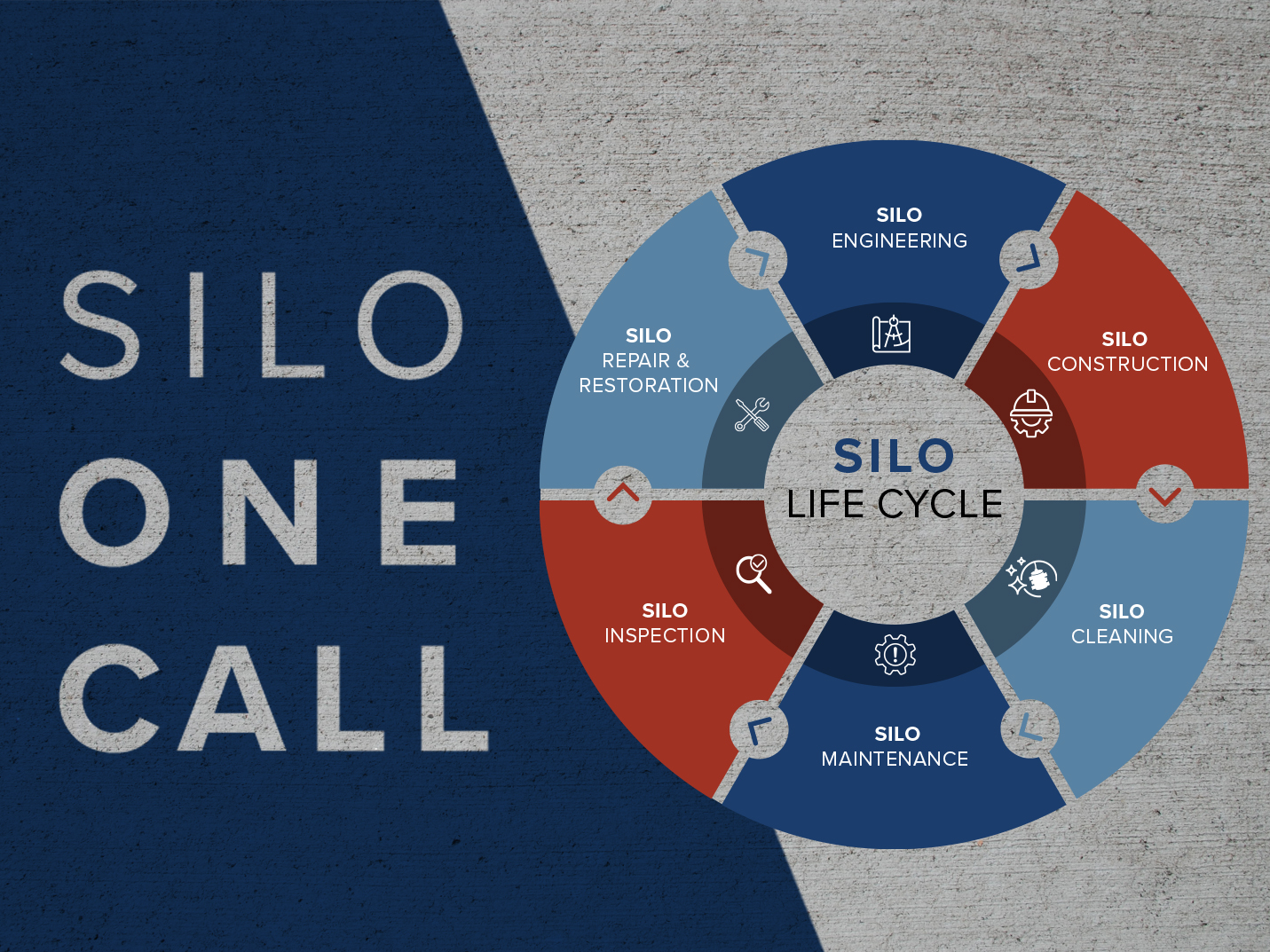Blog
CATEGORIES
Silos are used for storing and managing large quantities of materials and are at the heart of many industrial operations. Yet essential maintenance services like professional inspections can be overlooked or pushed back from a desire to reduce planned downtime or even in an attempt to save costs. Yet by proactively managing the maintenance of silos, professionals can prevent potential hazards, maintain the productivity of your facility, extend useful silo life, and even reduce overhead costs.
Regular silo inspections are essential for maintaining safety and efficiency in facilities that use concrete and steel silos. These inspections are vital for identifying potential structural issues early, such as foundation deterioration, roof collapse, wall delamination, and corrosion. Early detection allows for preventive maintenance, which is far less costly than addressing a full structural failure or emergency silo repair. Regular checks also ensure the structural integrity of your silos, extend their lifespan, and safeguard the personnel working around them. Moreover, these inspections help avoid operational disruptions by addressing issues before they cause significant damage or downtime.
Determining The Optimal Silo Schedule
While a good rule of thumb is to have your silos inspected annually or following two to five-year intervals, the most important factor is to make sure your professional silo inspections happen regularly. Proactive planning is not just about checking off a to-do list; it’s about ensuring that your silos remain operational and safe throughout the year. By scheduling inspections and maintenance tasks well in advance, you can help avoid the pitfalls associated with emergency services and unplanned downtime.
Scheduling inspections during seasonal slowdowns or planned shutdowns can help ensure that operations are not interrupted during peak periods. This strategic planning can enhance the safety and efficiency of silos, contributing to the overall productivity and profitability of the business. Scheduling your silo inspection at the same time as your silo cleaning and repairs not only helps you reduce unplanned downtime, it can also lower costs. Using one, trusted silo services company that can handle all aspects of your silo needs also simplifies the process for you.
Through inspection and maintenance, you increase the useful life of your silo, reduce unplanned downtime, and uphold production goals. What's more, the lack of silo maintenance is a leading cause of failure. The costs of keeping up with preventive maintenance are significantly lower than the price of major repairs or construction after a structural failure.
When it comes time to schedule your next silo inspection or repair services, one call to Marietta Silos can take care of it all.
Silo maintenance is an often-overlooked, yet critical component to keeping your silo safe and efficient for years to come. Regular silo inspections are the foundation of this necessary silo maintenance. Silo inspection is the most effective, preventive method to ensure concrete and steel structures remain safe and fully operational.
Our expert silo inspectors conduct thorough examinations to identify structural vulnerabilities, such as cracks or leaks, before they escalate into major issues. By addressing these concerns promptly, we save you from the hassle and expense of extensive, costly repairs down the road.
Just as routine silo inspections are an essential component of your maintenance program, so are regular cleanings. Our sister company, USA Silo Service provides professional silo cleaning services that can be bundled with our silo inspection programs to help you get the most for your money. By inspecting your cleaned silo, we're able to ensure all areas of the silo interior are included in the inspection.
Wonder what happens to all the material buildup that is removed during a professional silo cleaning? USA Silo Service's vacuum truck service can help you remove, recover, and recycle all kinds of materials during your professional silo cleaning.
Proper cleaning and maintenance of your silo will extend its useful life and reduce the need for costly repairs and cleanings. Learn more about USA Silo Service's vacuum truck services in their latest blog, or schedule your next Silo Inspection.
Just one call can take care of it all.
With our One Call Silo Service, you're able to schedule emergent and non-emergent silo and bin services with just one call. Regardless of your location in the US or your industry, Marietta Silos and USA Silo Service provides fast, cost-effective services for all aspects of your silos.
When you call 800-633-9969, you'll speak with one of our expert silo service team members who can help recommend the best service for your needs and schedule a fast mobilization to help minimize downtime.
Call the Marietta Silos One Call for any of the following silo services.
Silo Cleaning
Our silo-cleaning machine is the boss of silo cleaning because it is the fastest and most efficient approach in the industry.
Schedule your next silo cleaning today.
Silo Inspection
When was our last silo inspection? Best practices recommend professional inspections at two- to five-year intervals to help identify any issues that could lead to silo failure.
Silo Maintenance
From fluidizing equipment to exterior and rooftop coating, we have your silo maintenance needs covered.
Don't delay. Get your annual silo maintenance scheduled today.
Silo Restoration
We are the largest silo restoration and silo repair company in the United States and have been restoring silos for over 100 years.
Silo Repair
Need a regular or emergency silo repair? Call us today to schedule your inspection so we can provide a quote.
Silo Engineering
Our team offers specialized silo engineering services tailored to specific industries, including aggregates, manufacturing, cement, coal, power, and more. We understand the unique requirements of each industry and how the proper silo design can optimize operations and increase efficiency.
Silo Construction
Ready to move forward with the construction of a new silo? We custom-build a variety of concrete silos. Our array of Jumpform, Slipform, and concrete stave silo building techniques provide you with the silo solution that is best for you.
Want to learn more about the silo services we offer? View our infographic.






